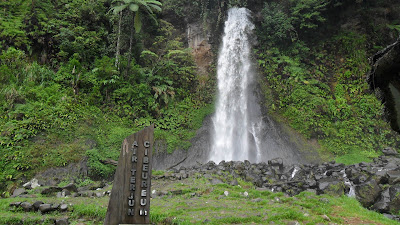The oldest human inhabitant archaeological findings in the region were unearthed in Anyer (the western coast of Java) with evidence of bronze and iron metallurgical culture dating to the first millennium AD. The prehistoric Buni culture (near present-day Bekasi) clay pottery were later developed with evidence found in Anyer to Cirebon. Artefacts (dated from 400 BC — AD 100), such as food and drink containers, were found mostly as burial gifts. There is also archaeological evidence in Batujaya Archaelogical Site dating from the 2nd centur and, according to Dr Tony Djubiantono, the head of Bandung Archaeology Agency, Jiwa Temple in Batujaya, Karawang, West Java was also built around this time.
One of the earliest known recorded history in Indonesia is from the former Tarumanagara kingdom, where seven fourth century stones are inscribed in Wengi letters (used in the Indian Pallava period) and in Sanskrit describing the kings of the kingdom Tarumanagara. Records of Tarumanegara's administration lasted until the sixth century, which coincides with the attack of Srivijaya, as stated in the Kota Kapur inscription.
The Sunda Kingdom subsequently became the ruling power of the region, as recorded on the Kebon Kopi II inscription.
An Ulama, Sunan Gunung Jati, settled in Cirebon, with the intention of spreading the word of Islam in the pagan town. In the meantime, the Sultanate of Demak in central Java grew to an immediate threat against the Sunda kingdom. To defend against the threat, Prabu Surawisesa Jayaperkosa signed a treaty (known as the Luso-Sundanese Treaty) with the Portuguese in 1512. In return, the Portuguese were granted an accession to build fortresses and warehouses in the area, as well as form trading agreements with the kingdom. This first international treaty of West Java with the Europeans was commemorated by the placement of the Padrao stone monument at the bank of the Ciliwung River in 1522.
Although the treaty with the Portuguese had been established, it could not come to realization. Sunda Kalapa harbour fell under the alliance of the Sultanate of Demak and the Sultanate of Cirebon (former
vassal state of Sunda kingdom) in 1524, after their troops under Paletehan alias Fadillah Khan had conquered the city. In 1524/1525, their troops under Sunan Gunung Jati also seized the port of Banten and established the Sultanate of Banten which was affiliating with the Sultanate of Demak. The war between the Sunda kingdom with Demak and Cirebon sultanates then continued for five years until a peace treaty were made in 1531 between King Surawisesa and Sunan Gunung Jati. From 1567 to 1579, under the last king Raja Mulya, alias Prabu Surya Kencana, the Sunda kingdom declined, essentially under the pressure from Sultanate of Banten. After 1576, the kingdom could not maintain its capital at Pakuan Pajajaran (the present-day Bogor) and gradually the Sultanate of Banten took over the former Sunda kingdom's region. The Mataram Sultanate from central Java also seized the Priangan region, the southeastern part of the kingdom.
In the sixteenth century, the Dutch and the British trading companies established their trading ships in West Java after the falldown of Sultanate of Banten. For the next three hundred years, West Java fell under the Dutch East Indies' administration. West Java was officially declared as a province of Indonesia in 1950, referring to a statement from Staatblad number 378. On October 17, 2000, as part of nationwide political decentralization, Banten was separated from West Java and made into a new province. There have been recent proposals to rename the province Pasundan ("Land of the Sundanese") after the historical name for West Java.
 |
Rice fields terrace in Priangan highland, West Java in 1926 |































